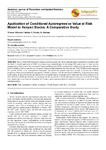| dc.description.abstract | Value at Risk (VaR) became the industry accepted measure for risk by financial institutions and their regulators after
the Basel I Accords agreement of 1996. As a result, many methodologies of estimating VaR models used to carry out risk
management in finance have been developed. Engle and Manganelli (2004) developed the Conditional Autoregressive Value at
Risk (CAViaR) which is a quantile that focuses on estimating and measuring the lower tail risk. The CAViaR quantile measures
the quantile directly in an autoregressive framework and applies the quantile regression method to estimate the CAViaR
parameters. This research applied the asymmetric CAViaR, symmetric CAViaR and Indirect GARCH (1, 1) specifications to KQ,
EABL and KCB stock returns and performed a set of in sample and out of sample tests to determine the relative efficacy of the
three different CAViaR specifications. It was found that the asymmetric CAViaR slope specification works well for the Kenyan
stock market and is best suited to estimating VaR. Further, more research needs to be carried out to develop e a satisfactory VaR
estimation model. | en_US |

